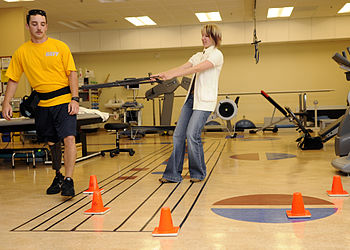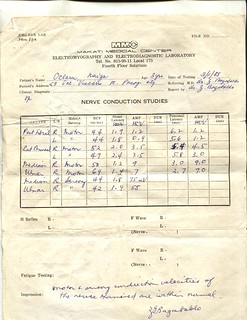 |
| US Navy 100723-N-7214P-020 Machinist's Mate Fireman George F. Avinger practices cone drills during physical therapy in the Comprehensive Combat and Complex Casualty Care facility at Naval Medical Center San Diego (Photo credit: Wikipedia) |
Like many health care professions, the ever-changing demographics of the American population is
 |
| Physical therapist coaches wounded warrior during training session. (Photo credit: Official U.S. Navy Imagery) |
Typical Day
 |
| Typical locations of arthroscopic surgery incisions in a knee joint following surgery for a tear in the meniscus. (Photo credit: Wikipedia) |
Based on the examination and the PT’s evaluative judgment, the PT will determine patients' diagnosis, prognosis, and plan of care that describes evidence-based treatment strategies and the anticipated functional outcomes. The PT will usually instruct the patient about the Do’s and Don’t’s, now that the patient is post-op. This may include stretching and strengthening exercises, ice and heat protocols, medications, bracing, etc. The PT also provides the patient with an overview of what to expect whenever they’re undergoing PT sessions. Subsequently, a schedule of physical therapy is set with specific goals in mind for each session, depending upon the patient’s rate of rehabilitation. These sessions usually include strengthening and stretching, and taking steps to minimize swelling (and reduce pain) such as using ice, ultrasound, etc. Finally, as a part of the plan of care, PTs determine the patient's ability to be independent and reintegrate them into the community or workplace after surgery, injury or illness. But since PTs treat a variety of conditions across a broad range of clients, no two days are the same, which makes for an interesting work load.
 |
| First diagnosis (Photo credit: azian_ao) |
Work Environment
PTs practice in a variety of settings: hospitals, outpatient clinics, private offices, home health agencies, schools, sports and fitness facilities, work settings, and skilled nursing facilities. Most full-time PTs work a 40- to 45-hour week. Depending upon one’s work situation, this may include some evenings and weekends. If a PT is part of a professional or collegiate sports team, there may be extensive travel during the season. Likewise, if they’re members of a traveling health care team (military or otherwise). Most PTs say the hours are reasonable and often flexible, allowing them to have families, enjoy their time off, pursue hobbies, take vacations, etc. The remuneration, they say, isn’t bad either; usually greater than $80k per year. Instructors and professors and those in administrative capacities can earn even more.
 |
| Approximately five dozen of the Guantanamo captives were amputees, who needed physical therapy. (Photo credit: Wikipedia) |
requirements of a PT can be demanding. Frequently they have to stoop, kneel, crouch, lift, and stand for long periods. In addition, PTs help ambulate patients, and sometimes are required move heavy equipment (including weights, exercise equipment, etc.) Knowing and practicing the proper mechanics of lifting, moving weights in space, are essential, lest one inadvertently injures a patient or themselves. Unless you transition into a strictly administrative position, you won’t become “chair shaped” if you become a PT.
Academic Requirements
Prior to being accepted into a PT program, a Bachelor of Science degree is mandatory (usually in biology, kinesiology, physiology, exercise science, etc.) and students must pass the GRE. Scoring well on that exam, as well as maintaining a high GPA is highly recommended, as PT training/education is demanding both academically and clinically. In fact, by 2015, all programs accredited by the Commission on Accreditation in Physical Therapy Education (CAPTE) must award the Doctor of Physical Therapy (DPT) degree. Individuals who wish to become a PT in the U.S. must earn their DPT degree from a CAPTE-accredited program, pass a national licensure examination, as well as meet the specific licensure requirements for the state(s) in which they practice.
In this article, I discussed a typical work day of a Physical Therapist. I touched upon why PT is one of health care's fastest growing profession, described the overall responsibilities of a PT, what a typical day is like, work environment and reviewed the academic requirements — which are soon changing — to becoming a licensed PT. If you found this article useful, please leave a comment below and also feel free to share and repost it.
Rick Fromme combines entrepreneurial enthusiasm with an insider's knowledge of the medical industry to co-found MedMasters.com. Both his drive and perspective helps provide health care professionals with a superior mechanism with which to communicate, network and market their strengths. Prior to founding MedMasters.com, Rick operated a highly successful medical device distributorship. Other milestones in his 12-year career in the medical industry include a key position at a medical device start-up company that was later sold to the Ethicon Endo division of Johnson & Johnson. You may reach Rick by connecting with him on Facebook, Twitter, Google+, LinkedIn and YouTube.












After my mom became hemiplegic following her brain cancer surgery, she benefited from going to her PT sessions. Which she was still among us.
ReplyDelete